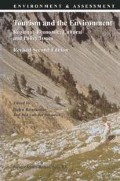Abstract
The analysis of tourism, and subsequent policy recommendations, are often heavily dependent upon the reliability of sample surveys. Whilst considerable attention is devoted to obtaining a reasonable sample size — so that statistically significance of sample means can be assessed — and to minimising other errors common to both complete counts and surveys1, relatively little recognition is given to the problems of sample selection and truncation bias in tourism and recreation surveys.
Access this chapter
Tax calculation will be finalised at checkout
Purchases are for personal use only
Preview
Unable to display preview. Download preview PDF.
References
Balkan, E. and J.R. Kahn, (1988) The value of changes in deer hunting quality: a travel-cost approach. Applied Economics 20, 533–539.
Bell, F.W. and V.R. Leeworthy (1990) Recreation demand by tourists for saltwater beach days. Journal of Environmental Economics and Management 18, 189–205.
Bockstael, N.E., W.M. Hanemann and I.E. Strand (1984) Measuring the Benefits of WaterQuality Improvement Using Recreation Demand Models. Washington DC: U.S. Environmental Protection Agency, Report CR–811043–01–1.
British Waterways (1989) Report and Accounts of the British Waterways Board 1988/89. Watford: British Waterways.
Deming, W.E. (1950) Some Theory of Sampling. Wiley, New York.
Department of Transport (1987) Values of Journey Time Savings and Accident Prevention. Department of Transport, London.
Garrod, G.D. and K.G. Willis (1990) Contingent Valuation Techniques: A Review of Their Unbiasedness, Efficiency and Consistency. Countryside Change Working Paper Series. WP10. Countryside Change Unit, Department of Agricultural Economics and Food Marketing, University of Newcastle upon Tyne.
Kennedy, P. (1979) A Guide to Econometrics. Martin Robertson, Oxford.
Maddala, G.S. (1983) Limited-Dependent and Qualitative Variables in Econometrics. Cambridge University Press, Cambridge.
Maille, P. and R. Mendelsohn (1993) Valuing ecotourism in Madagascar. Journal of Environmental Management 38, 213–218.
Morey, E.R., W.D. Shaw and R.D. Rowe (1991) A discrete choice model of recreational participation, site choice, and activity valuation when complete trip data are not available. Journal of Environmental Economics and Management 20, 181–201.
Smith, V.K. and Desvousges, W.H. (1985) The generalised travel-cost model and water quality benefits. Southern Economic Journal 52, 371–381.
Smith, V.K. (1988) Selection and recreation demand. American Journal of Agricultural Economics 70, 29–36.
Tobias, D. and R. Mendelsohn (1991) Valuing ecotourism a tropical rain-forest reserve. Ambio 20, 91–93.
Willis, K.G. and J.F. Benson (1989) Values of User Benefits of Forest Recreation: some further site surveys. Report to the Forestry Commission, Edinburgh.
Willis, K.G. and G.D. Garrod (1990) The individual travel-cost method and the value of recreation: the case of the Montgomery and Lancaster Canals. Environment and Planning C, Government and Policy 8, 315–326.
Willis, K.G. and G.D. Garrod (1991a) An individual travel-cost method of evaluating forest recreation. Journal of Agricultural Economics 42, 33–42.
Willis, K.G. (1991). The recreational value of the Forestry Commission Estate in Great Britain: a Clawson-Knetsch travel cost analysis. Scottish Journal of Political Economy 38, 58–75.
Willis, K.G. and G.D. Garrod (1991b) Valuing open access recreation on inland waterways: on-site recreation surveys and selection effects. Regional Studies 25: 6, 511–524.
Author information
Authors and Affiliations
Editor information
Editors and Affiliations
Rights and permissions
Copyright information
© 2000 Springer Science+Business Media Dordrecht
About this chapter
Cite this chapter
Willis, K.G., Garrod, G.D. (2000). Tourism and Recreation Surveys: The Problems of Sample Selection and Truncation Bias. In: Briassoulis, H., van der Straaten, J. (eds) Tourism and the Environment. Environment & Assessment, vol 6. Springer, Dordrecht. https://doi.org/10.1007/978-94-015-9584-1_9
Download citation
DOI: https://doi.org/10.1007/978-94-015-9584-1_9
Publisher Name: Springer, Dordrecht
Print ISBN: 978-90-481-5385-5
Online ISBN: 978-94-015-9584-1
eBook Packages: Springer Book Archive

